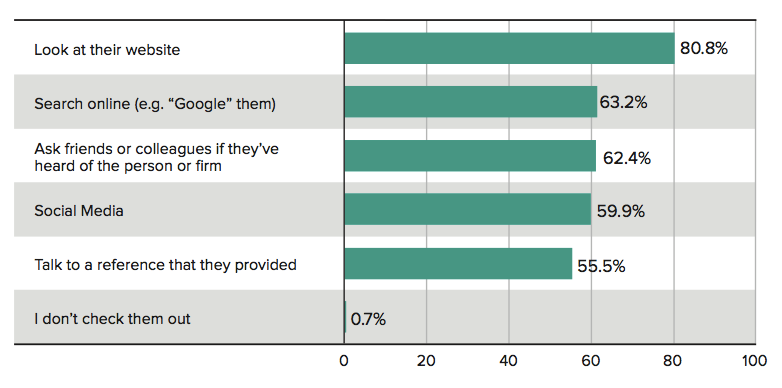How a High-Performance Website Feeds Your Firm’s Bottom Line
It is not Just About More “Clicks”
How important is a website? In this article, Dr. Lee Frederiksen shares what his research reveals about high-performing websites; it is not about more clicks.
 Some professional services firms have come a long way in how they use their websites—others, not so much. A growing body of research reveals that for the fastest-growing firms, high-performance websites are among their most powerful resources and greatest assets. In fact, to remain competitive in today’s marketplace, many more firms will need to adopt such websites—the sooner they do, the better their results will be.
Some professional services firms have come a long way in how they use their websites—others, not so much. A growing body of research reveals that for the fastest-growing firms, high-performance websites are among their most powerful resources and greatest assets. In fact, to remain competitive in today’s marketplace, many more firms will need to adopt such websites—the sooner they do, the better their results will be.
[su_pullquote align=”right”]Resources:
Building a New Business Pipeline
Developing, Marketing, and Managing a Boutique Litigation Services Practice
Make-Over Or Do-Over? Your Practice Building Workshop
[/su_pullquote]
What’s Under the Hood of a High-Performance Website?
You probably remember a time, not too long ago, when the typical website was little more than an electronic billboard with a few images and assorted company details. Such sites, sometimes called “branding websites” these days, can still serve a role—especially for startups still figuring out exactly what services they are offering and to whom. It is easy to understand why some leaders tend to view such websites as not worthy of a lot of attention.
But the times, they are a-changin’. The way individuals search for and evaluate potential professional services providers has changed, as have web technologies and strategies. Today, the best websites help organizations take advantage of these changes by functioning as complex lead-generation engines. We call these “high-performance websites” and here is how they work:
- Optimized web copy and content includes the keywords that matter most to your target audience, attracting prospective clients and referrals to visit your site.
- Although these visitors originally come to your site to see one piece of your content, they often end up exploring your site to see what other valuable content it includes—in the process, they learn more about you and your services.
- Throughout your site, carefully worded offers guide visitors to relevant content, such as webinars and free consultations. The more they see, the more closely they engage with you; even sharing their name and contact information in exchange for specialized and additional relevant content.
- This entire process could happen during one visit, but more likely will occur over the course of several interactions. Along the way, many visitors will qualify themselves as leads—some of those will eventually become clients.
Helping Buyers Realize Why They Need You
This strategy is often referred to as “content marketing” and a high-performance website is the essential platform on which it operates. For the most successful firms, it has become standard operating procedure—the most recent research on professional services marketing explains why.
The Hinge Research Institute surveyed more than 1,000 professional services firms in order to find out how their buyers go about evaluating potential providers. What we found may help you decide that your firm’s website needs a new approach.
Figure 1: How Buyers Evaluate Your Firm
What the data shows is that your website is the information source buyers use most often to learn about you. Other sources are useful as well, such as online search, friends and colleagues, and social media, but nothing beats a website as a source of information for buyers.
Figure 2: The Connection Between Online Lead-Generation and Profitability

Why, you might ask, should this insight matter to your firm? The data in Figure 2 shows that, in general, the more online leads you generate, the more profitable your firm will be. In fact, our research found that those firms which generate more than 60% of their leads online, are more than two times as profitable as those generating less than 20%.
This greater profitability is a direct result of two aspects of high-performance websites. First, their lead-generation infrastructure ensures a continuous flow of new visitors with engagements becoming increasingly close the more those visitors interact with you.
Second, these sites convey increased credibility for the firms, thanks to the impact of well-planned educational content and professional design. This credibility is important—important because more than half the people who receive referrals rule out some firms before even talking to them. More to the point, one of the chief reasons these buyers cite for ruling out those firms is an unimpressive website. This is why ensuring that your website is sleek and contemporary is not just nice to have, but actually helps to maximize your business.
What Should Your Lead-Generating Website Look Like?
Based on our research, high-performance websites tend to have a core set of elements. Some of the elements you should consider incorporating into your site include:
- Educational content
- Strategic offers
- Search engine optimization
- E-mail marketing
- Social media
- Design (for desktop and mobile)
- Web analytics
Effective, high-performance sites typically feature a well-integrated combination of these and other elements, which can be challenging to design and implement. To learn more about creating a lead-generating, high-performance website, click here.
Hinge Marketing has also created some free user-friendly resources for firms that are interested in creating their own high-performance websites. I invite you to download our Lead Generating Website Guide and Online Marketing for Professional Services book.
Lee W. Frederiksen, PhD, is Managing Partner at Hinge, the leading branding and marketing firm for the professional services. Hinge conducts groundbreaking research into high-growth firms and offers a complete suite of services for firms that want to become more visible and grow.
Mr. Frederiksen can be contacted at (703) 391-8870 or by e-mail to LFrederiksen@hingemarketing.com.









